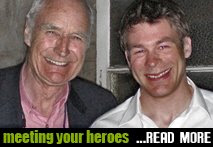I recently travelled to London on the new Wrexham & Shropshire trains in the hope of "a few words" with adventurer and comedian Michael Palin, only to find you should be careful what you wish for!
 CUTTING a lonely figure on Gobowen Station at 5am I can't help thinking I should have a voice over, at the very least a ticking clock and stirring BBC theme tune in the background.
CUTTING a lonely figure on Gobowen Station at 5am I can't help thinking I should have a voice over, at the very least a ticking clock and stirring BBC theme tune in the background.I was too young for Monty Python and as a nine-year-old, most TV was an excuse not to go to bed, but then came Around the World in 80 Days, which had me sitting gripped on the edge of our settee, as the impossibly nice and terribly British Michael Palin raced across mysterious far off countries from one adventure to the next.
There are not many people I'd get up at 4am to meet, but for the chance of a few words with Michael Palin I found myself on a cold Gobowen platform alongside a handful of hardy earlybirds as two white discs emerged from the black, rumbling through the frozen darkness as the sleek gunmetal grey Wrexham and Shropshire train glided into the station.
It's a far cry from Palin's adventures on ramshackle trains with as many passengers ontop of the train as inside it. Onboard the new state of the art carriages I therefore feel a bit of a fraud as I slump into the smart grey seats of standard class. Incidentally if grey seems to be a recurring colour there's a good reason. In their attempt to persuade people out of their cars the operators explain they decided to emulate the understated greys, chromes and carbon-like materials of expensive cars that people seem to like so much.
 While the Palin of old may not recognise the luxury, he would certainly recognise the route I'm travelling. Infact it was on this route that one of the railways' staff found himself sitting next to the affable comedian, on his way to give a speech at his old school in Shrewsbury. So impressed with the service was Palin that he had offered free of charge to help launch the new trains.
While the Palin of old may not recognise the luxury, he would certainly recognise the route I'm travelling. Infact it was on this route that one of the railways' staff found himself sitting next to the affable comedian, on his way to give a speech at his old school in Shrewsbury. So impressed with the service was Palin that he had offered free of charge to help launch the new trains.I use the first part of my 3hour 47minute journey to gen up on Mr Palin, but trying to think of questions he might not have been asked in his thousands of interviews is a real challenge. Almost all seats on the trains now have a table, laptop power points and free WiFi internet, so I spread myself out and carry on reading his Monty Python dairies. There's plenty I want to ask him; What his old school reports say? What does he list for 'occupation' on his passport? ...and was that parrot really just sleeping?
The trains are stunningly quiet, even the wheels have been coated to reduce noise and as we charge southwards I fall asleep, victim of comfortable seats, and a 4am start. I would normally wake in a panic (having woken up in Abergavenny before now), but the direct service means you can relax, assured of ending up in London, and I wake to find the carriage has filled around me with visitors and commuters combining country living with London wages.
London Marylebone is a pleasant place to arrive; small, unintimidating and just metres from the waiting busses and tubes, but as more and more journalists began to gather, I realised my chances of interviewing Palin were getting smaller by the minute.
 It's a sad fact of journalism that newspapers almost invariably play second fiddle to TV cameras.Amidst a sea of cameras all hope seemed lost.
It's a sad fact of journalism that newspapers almost invariably play second fiddle to TV cameras.Amidst a sea of cameras all hope seemed lost.Being usefully taller I got the photos I needed, but the ever smiling Palin was quickly ushered away to meet train bosses, MPs and the waiting TV cameras.
At this point in one of his adventures we would be listening to Palin's narration, describing an ingenious solution the difficult obstacle infront of him.
"This looked like turning into a disaster," said my own Palin voice over unhelpfully as the minutes ebbed away.
Then came my chance. As he made to leave I headed him off at the pass and grabbed the unfortunate 66-year-old as he waved his goodbyes: "Oh! Hello, how do you do? A picture? Yes of course," smiled the bewildered Palin as a hired help snapped our photo.
And that was it. Not the indepth, inciteful interview I had hoped or planned for, but perhaps a fitting reflection of my own trip on the new Wrexham and Shropshire trains. Just like the service to London, it's invariably the destination that entices us, but more often we find that it's all about the journey.








